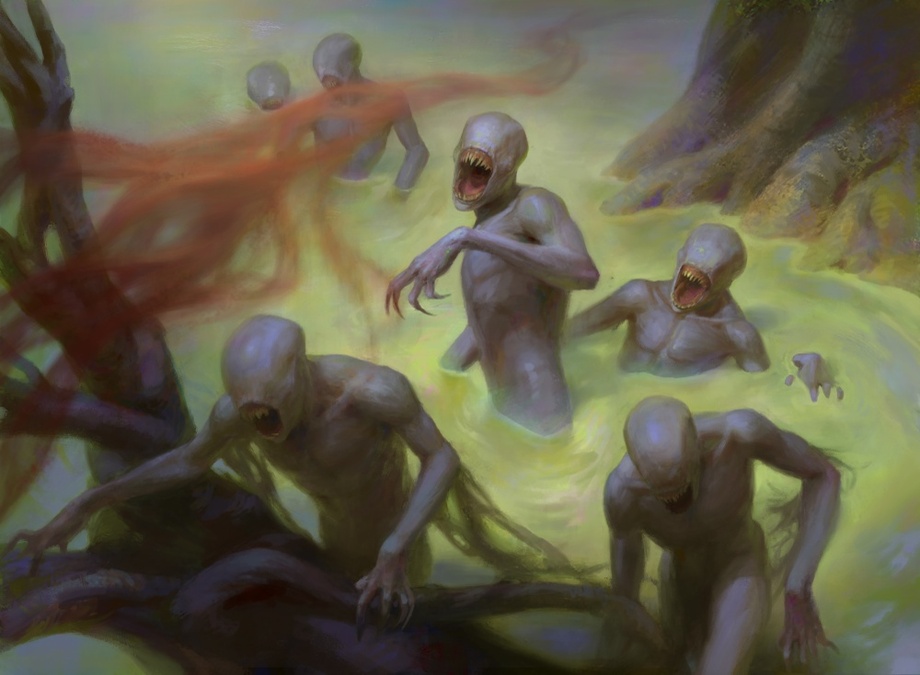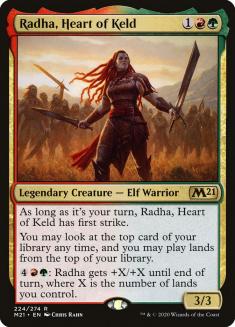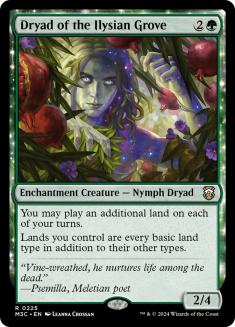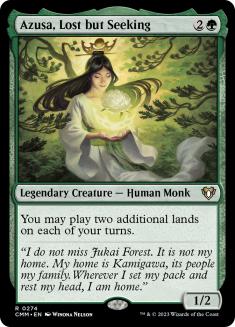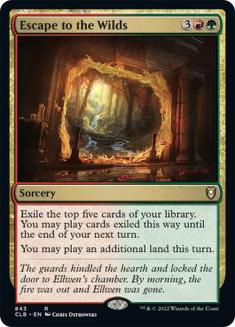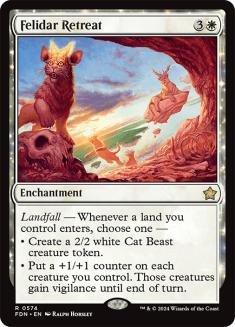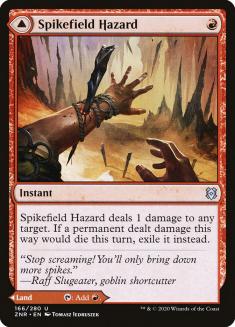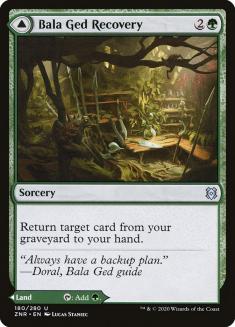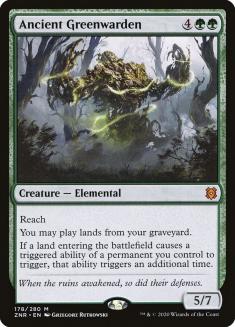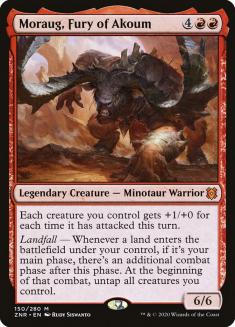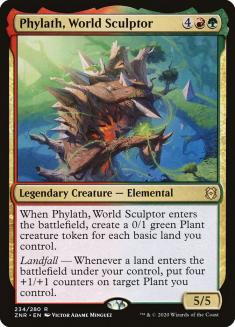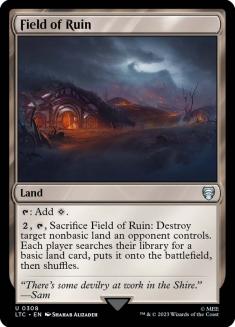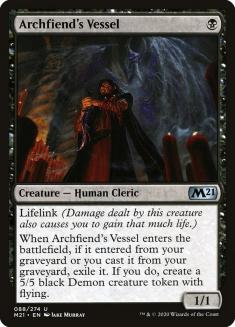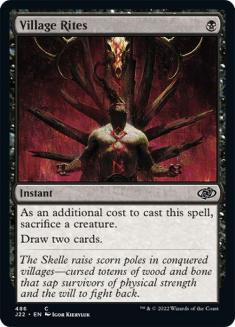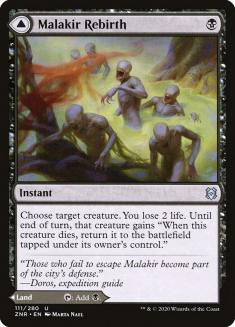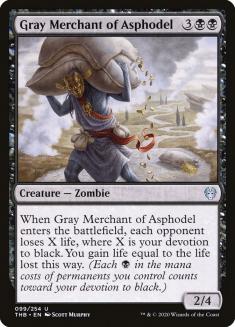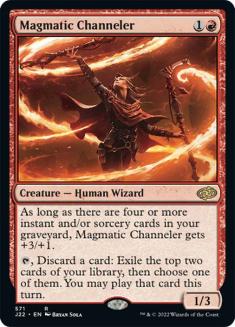I’m excited about Standard rotation and Zendikar Rising. Zendikar Rising seems, as far as I can tell at this point, to be a great set for Constructed. It has a lot of strong cards, but their strength is in consistency and flexibility, or maybe sometimes in synergy, but not in raw power. Nothing looks like it might need to be banned, the number of playable cards seems very deep, and as an added bonus, the modal double-faced cards (DFCs) encourage playing small numbers of copies, which maximizes varied gameplay. The only thing that dampens my enthusiasm for the future of Standard is the continued inexplicable legality of Uro, Titan of Nature’s Wrath, but for now, I’m willing to ignore that problem and hope it’ll go away.
Like many others, I’m immediately drawn, unusually for me, to Gruul Landfall. Bryan introduced the basic shell I’m excited about, but he has a very different take on it than I do.
For me, the core here is the three mana creatures — Radha, Heart of Keld; Dryad of the Ilysian Grove; and Azusa, Lost but Seeking. From there, I want as many lands as possible to maximize my ability to roll lands onto the battlefield from the top of my deck. This is a shared element with Bryan, but where Bryan’s very interested in Nahiri’s Lithoforming, I think that’s one of several possible things you can do at the top of this engine, and honestly, not one I’m most optimistic about.
Where I disagree with Bryan is that I think the last core piece of this strategy is actually Escape to the Wilds. I want to cast Dryad of the Ilysian Grove or Azusa, Lost but Seeking and play an extra land on Turn 3, and then cast Escape to the Wilds as often as possible. I believe this is the fastest, most explosive, most reliable card advantage plan that requires the least setup.
Nahiri’s Lithoforming can do explosive things if you have some landfall triggers, but Escape to the Wilds can do that also, while having a much lower floor if you don’t have landfall triggers. Bryan combines Nahiri’s Lithoforming with Ancient Greenwarden to replay the lands you’ve sacrificed, but that’s a two-card combo that involves keeping a six-mana creature on the battlefield and the outcome is Finale of Revelation and some landfall triggers. I’m not buying it.
But if I were to buy it, just hypothetically, I’d be a lot more interested if we combined it with Felidar Retreat, which is a pretty easy splash in a deck like this for a reliable high-impact landfall trigger.
So how would I build Gruul Lands?
I want to play a tapped land on Turn 1 and then cast Lotus Cobra or Tangled Florahedron on Turn 2, but I could easily see Bonecrusher Giant becoming another possible Turn 2 play if two-damage removal ends up strong in the format. The curve is glutted with synergistic three-mana creatures, and then I want some kind of late-game, so here’s what I’m looking at:
Nonlands:
- 4 Lotus Cobra
- 3 Radha, Heart of Keld
- 4 Dryad of the Ilysian Grove
- 2 Azusa, Lost but Seeking
- 4 Escape to the Wilds
Modal DFCs:
- 4 Tangled Florahedron
- 4 Kazandu Mammoth
- 4 Shatterskull Smashing
- 4 Turntimber Symbiosis
- 2 Spikefield Hazard
- 2 Bala Ged Recovery
Lands:
This is 51 cards that I consider the core I want to work with. I’m prioritizing different modal DFCs than Bryan. I agree with Ari that Kazandu Mammoth is just too good not to play; even though this deck has plenty of three-mana creatures, it’s just a stronger card than the other modal DFCs.
Spikefield Hazard is great because it’s like a sideboard card or a land. Being able to spend one mana to kill your opponent’s Lotus Cobra is great, and decks like Dimir Rogues will have a lot of one-toughness creatures. It’s also really nice to be able to shoot an Uro on its first casting to exile it.
Bala Ged Recovery is great just because it’s a strong spell in the late-game, when you’re least likely to want it to be a land.
With the last nine cards, you have a lot of options. I want to minimize the number of spells that aren’t DFCs, but I think you can play more than this. This is only seventeen, and I think this deck is probably fine with “only” maybe 32-40 lands. I could easily see playing an additional Radha or Azusa; this core is just my presumptive minimums. The best cards here are powerful creatures to hit with Turntimber Symbiosis.
There are several strong contenders for that role:
Kazandu Stomper and Kogla, the Titan Ape are probably worse than these three. I’m really not sure which of these is best though, but my default inclination would be to play a variety of them. This is good because two of them are legendary, and they cost enough mana that I might have drawn multiples and I’ll want to be able to prioritize which one I cast, but more importantly, since these are here largely for Turntimber Symbiosis, I’d rather have a wider variety of hits when I cast that spell.
My first instinct is simply to play one of each of these to bring me to a solid twenty spells, but that would just be to get a feel for them. I’d expect to tweak the numbers and likely end up with some slightly different mix. You could also include Terror of the Peaks or Elder Gargaroth in this mix.
Adding three big creatures leaves me with six additional lands to add to the deck. I really dislike Temple of Abandon in this archetype. I think that with so many lands, Lotus Cobra, and Dryad of the Ilysian Grove, colored mana will never be an issue, and I think scrying is worse than just having a spell you can cast on the other side of your land.
You could play Field of Ruin, which is nice because it’s an untapped land that can give you an extra landfall trigger (not that this deck is really designed to optimize those), but I think you’d either need more basic lands or fewer Fabled Passages so that you don’t run out if you do that. I like it more in decks with more landfall triggers.
My preference is actually just to include a mix of six additional modal DFCs to round the deck out, and I think you want small numbers of each of them so that you have a lot of options when you’re playing. It’s worth noting that you can include off-color DFCs thanks to Lotus Cobra and Dryad of the Ilysian Grove, and I actually think Emeria’s Call is totally reasonable here.
Creatures (25)
- 2 Azusa, Lost but Seeking
- 4 Lotus Cobra
- 1 Klothys, God of Destiny
- 4 Dryad of the Ilysian Grove
- 3 Radha, Heart of Keld
- 4 Tangled Florahedron
- 1 Moraug, Fury of Akoum
- 1 Phylath, World Sculptor
- 4 Kazandu Mammoth
- 1 Ancient Greenwarden
Lands (14)
Spells (22)

It’s hard to build a sideboard at this stage, but I think Valakut Exploration is a great sideboard card for this kind of deck, and I like Vivien and Ugin a lot here. Beyond that you want whatever interactive spells the deck ends up needing to beat whatever it ends up struggling with.
Note that I also ended up adding Klothys, God of Destiny rather than a 40th land. This deck is pretty good at generating devotion to red and green and I’m interested in more incidental hate for Uro, so I think there’s a good chance it earns a slot in the maindeck despite the high competition both for three-mana creatures and for nonland cards.
You could easily use the nine flex slots for 1 Plains, 4 Felidar Retreat, and 4 Nahiri’s Lithoforming; change the DFCs around to account for white mana; and maybe try to find room for a couple of Ancient Greenwardens for a Naya take on this deck that’s a bit more combo-focused.
Changing gears completely, the other project that has my attention at the moment is attempting to find a shell for the combination of Archfiend’s Vessel, Village Rites, and Malakir Rebirth. This three-card combo gives you a 5/5 flying Demon on Turn 2, but the cards generally play well together in any combination and play well with similar additional cards. There are a lot of different shells you could play with this package.
Take, for example, Mono-Black Devotion:
Creatures (29)
- 4 Gray Merchant of Asphodel
- 2 Murderous Rider
- 2 Ayara, First of Locthwain
- 2 Woe Strider
- 4 Mire Triton
- 2 Tymaret, Chosen from Death
- 2 Nightmare Shepherd
- 3 Lurrus of the Dream-Den
- 2 Serrated Scorpion
- 4 Archfiend's Vessel
- 2 Nullpriest of Oblivion
Lands (15)
Spells (16)

There are a lot of different ways to build this deck, but the basic ideas I’m looking at are Malakir Rebirth, Lurrus of the Dream-Den, and Agadeem’s Awakening to combine with Archfiend’s Vessel, Mire Triton to enable Lurrus and Agadeem’s Awakening, and sacrificing Gray Merchant of Asphodel to trigger it again with Malakir Rebirth, Nightmare Shepherd, or Nullpriest of Oblivion. Beyond that, it’s just a mix of interaction and black mana symbols.
There’s another approach that focuses on pressuring your opponent’s hand with Acquisitions Expert and Liliana, Waker of the Dead, and with more creatures you can maybe use Demon’s Disciple. Whisper Squad can replace Serrated Scorpion and two other cards as a way to build your devotion to black over time that might make casting Village Rites a little easier.
Another option is to play Rakdos to play up Threaten effects and sacrificing:
Creatures (22)
- 4 Woe Strider
- 4 Mire Triton
- 4 Kroxa, Titan of Death's Hunger
- 2 Lurrus of the Dream-Den
- 4 Whisper Squad
- 4 Archfiend's Vessel
Lands (14)
Spells (24)

Weaponize the Monsters, Witch’s Cauldron, and Witch’s Oven all serve very similar purposes with different advantages. You really only want to draw one total, but if you’re going to draw more than one, you’d rather draw two different ones, so I think playing roughly one of each makes sense.
One card I’m not sure about here is Magmatic Channeler. I opted not to play it, because a lot of your cards want to be cast only at the exact right time, but it is a good way to build material in the graveyard for Lurrus and Kroxa, and it’s also just a high-impact creature that your opponent wants to answer that you can return with Lurrus and Agadeem’s Awakening, so it might be good.
I think a lot of this deck builds itself from the basic setup. Mire Triton plays so well with Lurrus, Kroxa, and Woe Strider; you need Woe Strider to have enough free sacrifice outlets to take advantage of Song-Mad Treachery; and the deck ends up being pretty tight. The only real flex slot outside of maybe tweaking some numbers as I see it is Whisper Squad, but I think it’s pretty good with the sacrifice payoffs.
Another great card to combine with either Village Rites or Malakir Rebirth is Uro, since you know it’s going to die when you cast it, sacrificing it to either spell lets you get some extra value out of it. Actually building a deck around this is tricky though, since, if we’re still trying to use Archfiend’s Vessel we’re talking about ideally having three black mana in the first two turns some portion of the time, and UUGG on four mana some portion of the time, but maybe we kind find a way to make something work here:
Creatures (25)
- 4 Lotus Cobra
- 4 Mire Triton
- 4 Uro, Titan of Nature's Wrath
- 4 Llanowar Visionary
- 2 Jolrael, Mwonvuli Recluse
- 4 Archfiend's Vessel
- 3 Kazandu Mammoth
Planeswalkers (7)
- 2 Garruk, Cursed Huntsman
- 2 Ashiok, Nightmare Muse
- 1 Vivien, Monsters' Advocate
- 1 Teferi, Master of Time
- 1 Nissa of Shadowed Boughs
Lands (20)
Spells (8)

This doesn’t have a sideboard because this isn’t the right approach — I just want to talk through my process to get to this point, and then where I’d go from here. So I started with the shell I described: Vessel, Rites, Rebirth with Uro. Jolrael plays well with Rites and Uro; Mire Triton is good with Uro. From there, I realized that my deck is going to be getting a lot of lands on the battlefield quickly, but I have a core of a bunch of cheap spells, so I need some high-impact cards to take advantage of my extra lands. As it happens, Sultai colors have a bunch of strong planeswalkers, so I just sprinkled a bunch of them in. I had to trim some of the black modal DFCs because I don’t want that much black mana in the deck.
So what’s the problem?
This is a Sultai deck with little to no interaction. What’s the solution? Cut Archfiend’s Vessel. I ended up with very few ways to take advantage of it and it obviously doesn’t make sense here if I’m not going make room for Lurrus or even a full set of Awakenings or Rebirths. Without that, does it really make sense to play Rites or Rebirth at all? Not especially.
So I can either scrap this deck entirely and realize that Sultai looks to want to be ramp + planeswalkers and removal, or I can abandon planeswalkers to make room for Lurrus to justify cards like Vessel and Mire Triton, but then I still haven’t really made room for removal and my deck still has the problem that I’m all cheap creatures and ramp, which doesn’t really make any sense.
Sometimes you just need to let an idea evolve and sometimes it takes you in a different direction than you wanted. I don’t think Vessel + Uro works, even if there’s some cute overlapping synergy there.
Okay, let’s try one last effort to find a different home for it, Orzhov Humans:
Creatures (27)
- 3 Giant Killer
- 1 Taranika, Akroan Veteran
- 2 General's Enforcer
- 3 General Kudro of Drannith
- 2 Lurrus of the Dream-Den
- 4 Whisper Squad
- 4 Seasoned Hallowblade
- 4 Archfiend's Vessel
- 4 Luminarch Aspirant
Planeswalkers (1)
Lands (16)
Spells (16)

It’s very possible that this is best without the Rites/Rebirth/Lurrus/Vessel package and instead just pushing a strong curve of cheap humans with 4 General Kudro of Drannith and 4 Sanctuary Lockdown with a couple of Elspeths to go wide, but Lurrus definitely adds something. I don’t really think working to make Archpriest of Iona strong is worth it in Orzhov Humans. Too many of the cards you want aren’t party members and you have plenty of reasonable one-mana options, especially if you’re playing a lot of cards that make you creatures better, which improves all the lifelink options (weirdly, there are four different legal Orzhov 1/1 lifelink Humans for one mana in Standard).
Some kind of Humans deck does look good, but as far as doing cute things with Malakir Rebirth and Village Rites goes, I think we’re best off sticking with black or Rakdos.
The main thing I disagree with in most decks I’ve seen is people playing too many Temples and not enough modal DFCs. Time could prove me wrong on this, but at least in the beginning, I plan to stick to a guideline of playing lots of modal DFCs as my only tapped lands whenever possible.

